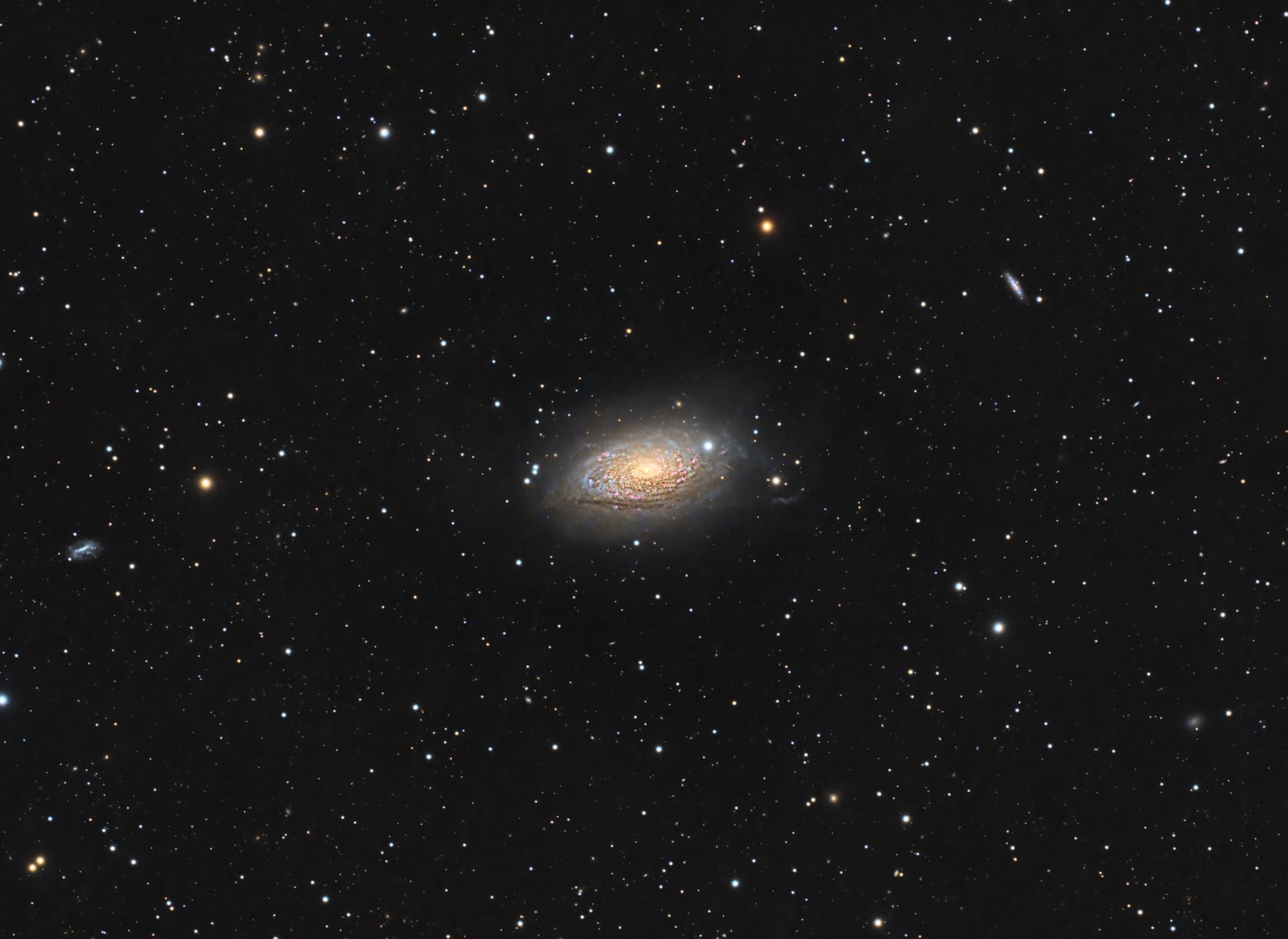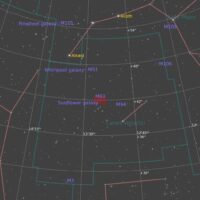M63, The Sunflower Galaxy
 Click image for full size version
Click image for full size version
June 4, 2022
Looking at the mottling in the spirals of this galaxy it’s easy to see why it’s known as the Sunflower Galaxy (also known as M63 – the 63rd entry in the Messier catalogue). There are a lot of red emission nebulae in this galaxy; these are structures similar to our own galaxy’s Orion Nebula. In spite of its vast distance (37 million light years), it covers more than 1/3 of the moons width — speaking to its immense size. I prepared an annotated image that shows the location of dozens of other galaxies.
Tekkies:
Acquisition, focusing, and control of Paramount MX mount with N.I.N.A., TheSkyX and PHD2. Focus with Optec DirectSync motors and controller. Equipment control with PrimaLuce Labs Eagle 4 Pro computer. All pre-processing and processing in PixInsight. Acquired from my SkyShed in Guelph. Average transparency and seeing. Acquired January 29-May 11, 2022, mostly under a moon-free sky.
Sky-Watcher Esprit 150 f/7 refractor and QHY600M camera with Optolong UV/IR and 3nm H-alpha filters
35x10m Ha = 5hr50m
239x5m OSC = 19hr55m
The WeightedBatchPreProcessing script was used to perform calibration, cosmetic correction, weighting, registration, local normalization and integration of all frames.
DrizzleIntegration was applied to the OSC frames, and the result was aligned to the Luminance master with StarAlignment. This yielded aligned Ha, Lum and Colour masters.
DynamicBackgroundExtraction was applied to the luminance and OSC masters (not required for Ha).
ColorCalibration was used to calibrate the OSC master..
Colour and H-alpha
Linear Noise Reduction: NoiseXterminator was used to reduce noise in the background areas of each image with settings Amount=0.9 and Detail=0.25
Stretching: HistogramTransformation was applied to each image to make a pleasing yet bright image.
H-alpha Blending: The NBRGBCombination script was used to blend Ha with the RGB with default settings. Colour calibration was performed after this additions
Luminance
Deconvolution: A star mask was made from the Luminance master to use as a Local Deringing Support Image. A stretched clone of the H-alpha image was used to make a mask selecting bright regions of the nebula for deconvolution. Deconvolution was applied (30 iterations, regularized Richardson-Lucy, ParametricPSF mode with default settings; Global dark deringing = 0.02; Global bright deringing 0.007).
Linear Noise Reduction: NoiseXterminator was used to reduce noise in the background areas with settings Amount=0.9 and Detail=0.25
Stretching: HistogramTransformation was applied to make a pleasing yet bright image.
Combining Luminance and Color Images
Luminance addition: LRGBCombination was applied to replace the lightness of the RGB image with the Luminance master.
Additional Processing
Star Removal: StarNet v2 was used to remove stars.
Nonlinear Noise Reduction: NoiseXterminator was used to reduce noise in the background areas of each image with settings Amount=0.9 and Detail=0.25
Contrast Enhancement: LocalHistogramEqualization was applied using an inverted lightness mask to protect the background and select the nebula. Three passes were applied (scale 20, max contrast 1.5, strength 0.5, 1 iteration; scale 80, max contrast 1.5, strength 0.4, 1 iteration; and scale 150, max contrast 1.5, strength 0.18).
Sharpening: MultiscaleMedianTransform was used to sharpen Layers 2 – 4 with strengths of 0.07, 0.05 and0.03, respectively.
Star Restoration: Stars removed using StarNet2 above were added back into the image using straight addition in PixelMath.
Final Steps: Background, galaxy and star brightness, contrast and saturation were adjusted in several iterations using CurvesTransformation with masks as required. ICCProfileTransformation (sRGB IEC61966-2.1; Relative Colorimetric with black point compensation) was applied prior to saving as a jpg.








Gorgeous image!
Nice image Ron! Shooting this one tonight. Thanks for the workflow guide.